Attached files
Exhibit 10.1
AMENDMENT NUMBER SEVEN
TO AMENDED AND RESTATED GOOGLE SERVICES AGREEMENT
This Amendment Number Seven to Amended and Restated Google Services Agreement (the “Amendment”), effective as of April 1, 2011 (the “Amendment Effective Date”), is between Google Inc. (“Google”) and InfoSpace Sales LLC (“Customer”) and amends the Amended and Restated Google Services Agreement, dated October 1, 2005, as amended (the “GSA”), and the Google Services Agreement Order Form, dated October 1, 2005, as amended (the “Order Form” and together with the GSA, the “Agreement”). Capitalized terms not defined in this Amendment have the meanings given to those terms in the Agreement. The parties agree as follows:
| 1. | Term Extension. The Term is extended through March 31, 2013. Customer may extend the Term through March 31, 2014 with written notification to Google by December 31, 2012, provided, however, that this option to extend the Term is available only to InfoSpace Sales LLC and not to any successor-in-interest or assignee of this Agreement. |
| 2. | Test Period. The period from April 1, 2011 through June 30, 2011 will be the “Test Period” during which time the parties will work together in good faith to run tests to [*] (as defined below). |
| 3. | Implementation Definitions. “[*] Implementation” means an implementation in which [*], an example of which is attached hereto as Attachment 1 [*]. “[*] Implementation” means an implementation in which [*], an example of which is attached hereto as Attachment 2. |
| 4. | Notification of Election. Customer will notify Google on or before June 30, 2011 of its election to either continue with the [*] Implementation or proceed with the [*] Implementation across all Sites, which election will remain in place for the remainder of the Term (including Customer’s optional extension through March 31, 2014 as applicable). If Customer elects the [*] Implementation, then Customer will have 60 days following the end of the Test Period to complete the implementation transition across all Sites. If Customer does not notify Google of an election by June 30, 2011, then the default election will be the [*] Implementation. For the avoidance of doubt, beginning July 1, 2011 the [*] percentages of the elected implementation will be in effect. |
| 5. | WebSearch Fees. |
| a. | During the Test Period, the Search Fee for the WebSearch Service (as set forth on the cover page of the Order Form) will be [*] Search Result Sets. |
| b. | For the remainder of the Term following the Test Period, for Sites owned and operated by Customer, the Search Fee will be [*]. |
| c. | For the remainder of the Term following the Test Period, the Search Fee will be [*]. |
| 6. | AdSense for Search Fees. |
| a. | During the Test Period, the AFS Revenue Share Percentages and AFS Deduction Percentages will be amended as follows: |
| i. | For each [*] and (ii) the results pages of which are primarily directed and targeted to End Users in [*], the AFS Revenue Share Percentage is [*] and the AFS Deduction Percentage is [*]. |
| * | Information redacted pursuant to a confidential treatment request by InfoSpace, Inc. under 5 U.S.C. §552(b)(4) and 17 C.F.R. §§ 200.80(b)(4) and 240.24b-2, and submitted separately with the Securities and Exchange Commission. |
1
| ii. | For each [*] that is primarily directed and targeted to End Users [*], the AFS Revenue Share Percentage is [*] and the AFS Deduction Percentage is [*]. |
| iii. | For each [*] and (ii) the results pages of which are primarily directed and targeted to End Users [*], the AFS Revenue Share Percentage is [*] and the AFS Deduction Percentage is [*]. |
| iv. | For each [*] that is primarily directed and targeted to End Users [*], the AFS Revenue Share Percentage is [*] and the AFS Deduction Percentage is [*]. |
| b. | For the remainder of the Term following the Test Period, if Customer elects the [*] Implementation, then the AFS Revenue Share Percentages and AFS Deduction Percentages will be amended as follows: |
| i. | For each [*] and (ii) the results pages of which are primarily directed and targeted to End Users [*], the AFS Revenue Share Percentage is [*] and the AFS Deduction Percentage is [*]. |
| ii. | For each [*] that is primarily directed and targeted to End Users [*], the AFS Revenue Share Percentage is [*] and the AFS Deduction Percentage is [*]. |
| iii. | For each [*] and (ii) the results pages of which are primarily directed and targeted to End Users [*], the AFS Revenue Share Percentage is [*] and the AFS Deduction Percentage is [*]. |
| iv. | For each [*] that is primarily directed and targeted to End Users [*], the AFS Revenue Share Percentage is [*] and the AFS Deduction Percentage is [*]. |
| c. | For the remainder of the Term following the Test Period, if Customer elects the [*] Implementation, then the AFS Revenue Share Percentages and AFS Deduction Percentages will be amended as follows: |
| i. | For each [*] and (ii) the results pages of which are primarily directed and targeted to End Users [*], the AFS Revenue Share Percentage is [*] and the AFS Deduction Percentage is [*]. |
| ii. | For each [*] that is primarily directed and targeted to End Users [*], the AFS Revenue Share Percentage is [*] and the AFS Deduction Percentage is [*]. |
| iii. | For each [*] and (ii) the results pages of which are primarily directed and targeted to End Users in [*], the AFS Revenue Share Percentage is [*] and the AFS Deduction Percentage is [*]. |
| iv. | For each [*] that is primarily directed and targeted to End Users in [*], the AFS Revenue Share Percentage is [*] and the AFS Deduction Percentage is [*]. |
| * | Information redacted pursuant to a confidential treatment request by InfoSpace, Inc. under 5 U.S.C. §552(b)(4) and 17 C.F.R. §§ 200.80(b)(4) and 240.24b-2, and submitted separately with the Securities and Exchange Commission. |
2
| 7. | Prohibited Actions. The following are added to Section 1.3.1 to the GSA: |
“(q) enter into any type of arrangement where a [*] party receives a payment in connection with Search Results and/or Advertising Results;
(r) [*]
| 8. | [*] Placement. As of the Effective Date, any Site implementing the AFS Service will implement in accordance with the [*] Placement/[*] Placement requirements. |
| 9. | Client Application Guidelines. The updated Client Application Guidelines are attached hereto as Attachment 3. The first sentence of Section 2.6 of the GSA is restated as follows: |
“Client Applications. Customer’s Client Application(s) set forth on the cover page(s) of the Order Form are hereby approved by Google for purposes of sending Queries for Search Services and/or AdSense Services to resolve to Results Pages on the Sites; provided that, at all times during any Term, Customer and Customer’s Client Application(s) will comply with the Guidelines and Google’s Client Application Guidelines, the current form of which is attached hereto as Attachement 3, as such Client Application Guidelines may be updated by Google from time to time pursuant to this Agreement, provided that Google provides Customer with written notice of such updated Guidelines and/or Client Application Guidelines and a commercially reasonable amount of time to comply with such updates, but not to exceed [*] days.”
| 10. | [*] |
| 11. | Terms for Syndicated Sites. The following provisions are added to Schedule A (Terms for Syndicated Sites) of the GSA: |
“4. In its sole discretion, Google may immediately suspend a Syndicated Site’s access to the Services with notice to Customer and Customer will have [*] days following notice to terminate the Syndicated Site’s use of the Services.
5. A new domain added as a Syndicated Site may not launch the Services until Google has completed its technical review and notified Customer of its technical approval. Google will provide Customer with an initial response of their technical review (which need not be an approval or disapproval) within 10 business days following submission. Google will use commercially reasonable efforts to provide prompt confirmation of approval or disapproval.
6. If the entity which owns or controls a Syndicated Site has a Change of Control Transaction, then Customer will promptly notify Google and Google may, at its option, suspend or terminate the Syndicated Site’s access to the Services.”
| 12. | Terms for Non-Hosted Syndicated Sites. The following provisions are added to Schedule B (Terms for Non-Hosted Syndicated Sites): |
“4. In its sole discretion, Google may immediately suspend any Non-Hosted Syndicated Site’s access to the Services with notice to Customer and Customer will have [*] days following notice to terminate the Non-Hosted Syndicated Site’s use of the Services.
5. A new domain added as a Non-Hosted Syndicated Site may not launch the Services until Google has completed its technical review and notified Customer of its technical approval. Google will provide Customer with an initial response of their technical review (which need not be an approval or disapproval) within 10 business days following submission. Google will use commercially reasonable efforts to provide prompt confirmation of approval or disapproval.
| * | Information redacted pursuant to a confidential treatment request by InfoSpace, Inc. under 5 U.S.C. §552(b)(4) and 17 C.F.R. §§ 200.80(b)(4) and 240.24b-2, and submitted separately with the Securities and Exchange Commission. |
3
6. If the entity which owns or controls a Non-Hosted Syndicated Site has a Change of Control Transaction, then Customer will promptly notify Google and Google may, at its option, suspend or terminate the Non-Hosted Syndicated Site’s access to the Services.”
| 13. | Rivals.com. All references to Rivals.com are hereby removed from the Agreement. |
| 14. | [*] |
| 15. | Indemnification. Section 5.3 of the GSA is amended and restated as follows: |
“Customer Indemnification. Customer will indemnify, defend and hold harmless Google, Google’s Affiliates, and their respective officers, directors and employees against any third party lawsuit or proceeding brought against Google based upon a claim that the Customer Content, Site, or Customer’s Brand Features infringe any copyright, trade secret, trademark, or U.S. patent of a third party.”
| 16. | Limitation of Liability. The third to last sentence of Section 6 of the GSA is amended and restated as follows: |
“NOTWITHSTANDING ANYTHING IN THIS SECTION 6 TO THE CONTRARY, WITH RESPECT TO GOOGLE’S INDEMNITY OBLIGATIONS FOR ANY THIRD PARTY CLAIMS MADE AGAINST CUSTOMER OR A SYNDICATED SITE PURSUANT TO SECTIONS 5.1 OR 5.2 AND ARISING OUT OF A CLAIM THAT ADVERTISING RESULTS INFRINGE ANY COPYRIGHT, TRADE SECRET, TRADEMARK OR U.S. PATENT OF A THIRD PARTY, GOOGLE’S MAXIMUM AGGREGATE LIABILITY SHALL NOT EXCEED [*]. “
| 17. | [*]. Prior to exercising its [*] as set forth in Section 9.2 of the GSA, Customer must first request a [*] from Google, which will be provided by Google within a reasonable time, but in any event no later than 10 business days following receipt of the request, and the parties will work together in good faith to resolve the need for an [*] using the [*]. The [*] will be from a reputable, independent certified [*] covering the key controls and validation mechanism in place to meet the [*] obligations under this Agreement. If Customer reasonably believes that there is a need for an [*] after reviewing the [*], then Customer will provide written notice to Google which will include a detailed explanation of the continuing need for an [*]. |
| 18. | WebSearch Queries. The following sentence is added to the end of Section 4.2.1 of the Order Form: “[*].” |
| 19. | Indexes. |
| a. | The second to last sentence of Section 4.2.2 of the Order Form is amended and restated as follows: “Further, Google shall provide Customer with Search Results from the internet search index used in Google’s generally available WebSearch Service.” |
| b. | The second to last sentence of Section 5.2.2 of the Order Form is amended and restated as follows: “Further, Google shall provide Customer with AFS Results from the advertising network used in Google’s generally available AFS Service.” |
| * | Information redacted pursuant to a confidential treatment request by InfoSpace, Inc. under 5 U.S.C. §552(b)(4) and 17 C.F.R. §§ 200.80(b)(4) and 240.24b-2, and submitted separately with the Securities and Exchange Commission. |
4
| 20. | Restricted Entities Update. The following entities are added to Exhibit C (List of Restricted Entities) of the GSA: [*]. |
| 21. | Third Party Ad Serving. Notwithstanding anything to the contrary in the Agreement, Google may provide advertisements to Customer through a third party ad server and these advertisements will be treated as Ads. |
| 22. | Gadget Ads. Notwithstanding anything to the contrary in the Agreement, Google may provide advertisements to Customer which are Gadget Ads and these Gadget Ads will be treated as AFC Ads. “Gadget Ads” are ads which appear in an interactive ad format. |
| 23. | Non-Ad Content. Notwithstanding anything to the contrary in the Agreement, Google may provide non-advertising content such as surveys (“Other Content”) with notice to Customer. Other Content may include non-text content. Customer may opt-out of receiving Other Content in its entirety with notice to Google within thirty (30) days following receipt of notice from Google. Customer may change its opt-out status with fifteen (15) days prior notice to Google. |
| 24. | Miscellaneous. The parties may execute this Amendment in counterparts, including facsimile, PDF, or other electronic copies, which taken together will constitute one instrument. Except as expressly modified herein, the terms of the Agreement remain in full force and effect. |
IN WITNESS WHEREOF, the parties have executed this Amendment by persons duly authorized.
| Google Inc. |
InfoSpace Sales LLC | |||||||
| By: | /s/ Nikesh Arora |
By: | /s/ Mike Glover | |||||
| Print Name: | Nikesh Arora |
Print Name: | Mike Glover |
| Title: | President, Global Sales/Business Development |
Title: | Vice President of Business Development | |||||
| Date: | March 31, 2011 |
Date: | March 31, 2011 | |||||
| * | Information redacted pursuant to a confidential treatment request by InfoSpace, Inc. under 5 U.S.C. §552(b)(4) and 17 C.F.R. §§ 200.80(b)(4) and 240.24b-2, and submitted separately with the Securities and Exchange Commission. |
5
Attachment 1
[*] Implementation
[*]
| * | Information redacted pursuant to a confidential treatment request by InfoSpace, Inc. under 5 U.S.C. §552(b)(4) and 17 C.F.R. §§ 200.80(b)(4) and 240.24b-2, and submitted separately with the Securities and Exchange Commission. |
6
Attachment 2
[*] Implementation
[*]
| * | Information redacted pursuant to a confidential treatment request by InfoSpace, Inc. under 5 U.S.C. §552(b)(4) and 17 C.F.R. §§ 200.80(b)(4) and 240.24b-2, and submitted separately with the Securities and Exchange Commission. |
7
Attachment 3
Client Application Guidelines
Client Application Guidelines
1. Introduction.
Google is committed to providing the best user experience possible. With this objective in mind, we have outlined a set of Software Principles (http://www.google.com/corporate/software_principles.html) that we believe our industry should adopt and have also established the following Client Application Guidelines (“Guidelines”) to apply to client applications that are used to access our search and/or advertising syndication services. Capitalized terms not defined in these Guidelines are defined in your Google Services Agreement (“Agreement”).
2. Accessing Services.
Only approved Client Applications that comply with the Agreement (including these Guidelines, which are incorporated into the Agreement) may access the Services and only to the extent permitted in the Agreement. To obtain Google’s approval for any client application not expressly approved in the Agreement, Customer must submit a written request to Google and Google may in its sole discretion approve or reject such client application. For the purposes of the Agreement, any client application that resets an End User’s default search engine to Google’s search services and/or resets the End User’s home page to a Site is deemed to be accessing a Google Service and Customer is prohibited from doing so unless Google has approved such client application as an approved Client Application.
3. No Google Branding or Attribution.
Approved Client Applications, and any related collateral material (including without limitation any offer and/or installation screens presented to the End User as part of the download process, Web pages promoting the approved Client Application or from which it is made available for download), must not contain any Google branding, trademarks or attribution.
4. General Disclosure and Consent Requirements for Approved Client Applications Distributed via Download.
Installation screens for approved Client Applications must be designed in a manner that ensures End Users are agreeing to the installation in a knowing and intentional manner. Prior to the installation of an approved Client Application on an End User’s computer, Customer must:
| • | first, fully, accurately, clearly and conspicuously disclose to End Users: |
| • | the name of the approved Client Application, identifying Customer as the entity responsible for it, |
| • | the principal and significant features and functionality of the approved Client Application; and |
| • | then, obtain the End User’s consent to install the approved Client Application. |
Appendix A contains a sample installation screen demonstrating the requirements of this Section 4.
5. Disclosure and Consent Requirements for Changes to an End User’s Settings.
5.1. Changes to Default Search and/or Homepage
5.1.1. Search-Based Client Applications. An approved Client Application that accesses the WebSearch Service or a similar web search service may, as part of the download process and with the End User’s consent, change the End User’s default search engine and/or homepage, provided the installation screens for such download strictly conform to the sample installation screens contained in Appendices A and B. Customer agrees that if the approved Client Application has features and functionality beyond search, the installation screens must clearly and conspicuously inform End Users of any change in default search functionality and such disclosure shall be at least as prominent as the disclosure in the installation screens pertaining to the non-search functionality of the approved Client Application.
5.1.2. Non-Search Based Client Applications. An approved Client Application that does not access the WebSearch Service or a similar web search service may, as part of the download process and with the End User’s consent, change the End User’s default search engine and/or homepage, provided that the installation screens for such download strictly conform to the sample installation screens contained in Appendices A and C.
| * | Information redacted pursuant to a confidential treatment request by InfoSpace, Inc. under 5 U.S.C. §552(b)(4) and 17 C.F.R. §§ 200.80(b)(4) and 240.24b-2, and submitted separately with the Securities and Exchange Commission. |
8
5.2. Changes to Other End User Settings. An approved Client Application may not make any changes to the operating system or application data settings on an End User’s computer (e.g., changing the default application for a file type, such as the default email, browser or media player application), unless prior to making such change Customer:
| • | first, fully, accurately, clearly and conspicuously discloses the change in a manner that will explain the practical effect of such change; and |
| • | then, obtains the End User’s affirmative consent to make such change. |
Notwithstanding the foregoing, no disclosure and consent need be made for changes to operating system or application data settings that have only a minor impact on End User experience, such as adding a small number of bookmarks to the browser menu or adding an item to a start menu.
6. Disclosure and Consent Requirements for Collection and Transmission of Personally Identifiable Information.
Approved Client Applications may not: (1) collect or transmit any End User’s personally identifiable information to any entity other than the End User, or (2) collect or transmit information related to an End User’s computer or Internet usage or activity in a manner that could collect or transmit such End User’s personally identifiable information (such as through keystroke logging), unless prior to the first occurrence of any such collection or transmission Customer:
| • | first fully, accurately, clearly and conspicuously discloses: |
| • | the type of information collected (described with specificity in the case of personally identifiable information), |
| • | the method of collection (e.g. by registration, etc.) and |
| • | the location of (i.e. a link to) the privacy policy that governs the collection, use and disclosure of the information, and |
| • | then obtains the End User’s affirmative consent to such collection and/or transmission. |
7. EULA and Privacy Policy.
Each of Customer’s approved Client Applications must conform with all applicable laws and regulations and must be distributed pursuant to an end user license agreement (“EULA”) that conforms with all applicable laws and regulations. In addition, Customer and its approved Client Application(s) must comply with the agreements and representations Customer makes with End Users in its EULA and privacy policy. Customer’s privacy policy must be readily and easily accessible from the approved Client Application. If an approved Client Application collects or transmits any other information related to the End User’s use of his or her computer, but not required to be disclosed and consented to pursuant to Section 6, then the collection and use of such other information must be clearly and conspicuously disclosed in Customer’s privacy policy.
8. Transparency.
Neither Customer nor any of its distribution or bundling partners may mislead End Users or create End User confusion with regard to the source or owner of an approved Client Application or its purpose, functionality or features. For example, all elements of an approved Client Application that are visible to the End User must clearly identify their source through its branding and attribution, and that identification, whatever form it takes, must correspond to the identification of Customer’s approved Client Application in the menu on the End User’s operating system that permits End Users to remove programs. Customer must clearly label advertisements provided by an approved Client Application (if any) as such and clearly identify the approved Client Application as the source of those advertisements. In addition, if Customer’s approved Client Application modifies the operation or display of other applications or Web sites (other than Web sites that Customer owns), then in each instance Customer must clearly and conspicuously attribute the source of that modification to the approved Client Application (as distinct from the application or Web site modified) in a manner that will reasonably inform a typical Internet user; provided that this requirement will not apply to modifications for which Customer obtains disclosure and consent pursuant to Section 5.
| * | Information redacted pursuant to a confidential treatment request by InfoSpace, Inc. under 5 U.S.C. §552(b)(4) and 17 C.F.R. §§ 200.80(b)(4) and 240.24b-2, and submitted separately with the Securities and Exchange Commission. |
9
9. Results Page Requirements.
For queries generated by an End User using an approved Client Application, Customer will ensure that that the display of Search Results or Ads on a Results Page conforms to one of the sample implementations set forth in Appendix D, and the Results Page will not contain any Google branding, trademarks or attribution, provided that Customer may label Search Results or Ads as Google results using Google’s name in text format. [*].
[*]
10. Distribution of Approved Client Applications as Part of a Bundle.
Approved Client Applications may be distributed as part of a bundle that installs Customer’s approved Client Application with one or more other applications. However, in such case, Customer may not access Services from any such approved Client Application unless it satisfies each of the following requirements:
| • | the End User is made aware of all of the applications included in the bundle prior to installation; |
| • | the level of disclosure pertaining to the approved Client Application is no less than the level of disclosure pertaining to each other application in the bundle; |
| • | no application in the bundle contains content that the approved Client Application is prohibited from containing under the Agreement; |
| • | each application in the bundle complies with Sections 4-8, 12 and 13 of these Guidelines; |
| • | if applications in the bundle are supported in part by revenue generated by advertising displayed in another independent application included in that bundle and the continued use of the approved Client Application is conditioned on such other independent application remaining installed and active on the End User’s computer, the End User is made aware of that relationship; and |
| • | either the bundle provides for a master uninstaller that enables the End User to uninstall every application in the bundle without undue effort or skill, or if no master uninstaller is provided, the de-installation of any application is not dependent or conditioned upon the de-installation of any other application included in the bundle. |
Customer is responsible for ensuring that all applications included in the bundle with the approved Client Application comply with the applicable provisions of these Guidelines. See Appendix F for sample screens regarding the de-installation of an application. In addition to the above, if Customer bundles any approved Client Application with any third party application, Customer will notify Google in writing prior to any distribution of the approved Client Application in such bundle.
11. Distribution of Approved Client Applications Pre-Installed on a Computer.
Customer will not distribute an approved Client Application pre-installed on a computer without the prior written consent of Google.
12. Prohibited Behavior.
An approved Client Application must not engage in deceptive, unfair, harassing or otherwise annoying practices. For example, an approved Client Application will not:
| (a) | use, or permit a third party to use, an End User’s computer system for any purpose not understood and affirmatively consented to by the End User (including, without limitation, for purposes of consuming bandwidth or computer resources, sending email messages, launching denial of service attacks, accruing toll charges through a dialer or obtaining personal information from an End User’s computer such as login, password, account or other information personal to the End User); |
| (b) | intentionally create or exploit any security vulnerabilities in an End User’s computer; |
| (c) | trigger pop-ups, pop-unders, exit windows, or similar obstructive or intrusive functionality that materially interfere with an End User’s Web navigation or browsing or the use of his or her computer; |
| (d) | repeatedly ask an End User to take, or try to deceive an End User into taking, an action that the End User has previously declined to take (such as repeatedly asking an End User to change his or her home page or some other setting or configuration); |
| * | Information redacted pursuant to a confidential treatment request by InfoSpace, Inc. under 5 U.S.C. §552(b)(4) and 17 C.F.R. §§ 200.80(b)(4) and 240.24b-2, and submitted separately with the Securities and Exchange Commission. |
10
| (e) | redirect browser traffic away from valid DNS entries (except that approved Client Applications may direct unresolved URLs to an alternative URL designated by Customer, provided that the page to which the End User resolves adequately informs the End User that Customer and the approved Client Application are the source of that page); |
| (f) | interfere with the browser default search functionality (except that an approved Client Application may permit an End User to change his or her default search engine with proper disclosure, consent and attribution as provided above); |
| (g) | engage in activity that violates any applicable law or regulation; or |
| (h) | contain any viruses, worms, trojan horses, or the like. |
13. Deactivation.
An approved Client Application shall not impair an End User’s ability to change any preferences or settings set by the approved Client Application and if an End User reverses the changes made by the approved Client Application to the End User’s default search and/or homepage settings, such reversal shall not impair the End User’s further use of the approved Client Application. Once an End User disables an approved Client Application, such application shall not be re-enabled without an affirmative action by the End User to explicitly re-enable such approved Client Application. Accordingly, no use, update, installation or re-enablement of a separate application, and no code downloaded as a result of browsing a Web site, may operate to re-enable an approved Client Application. An approved Client Application must permit End Users to uninstall it (in the customary place the applicable operating system has designated for adding or removing programs, e.g., Add/Remove Programs control panel in Windows – see Appendix F) in a straightforward manner, without undue effort or skill. In addition, an approved Client Application, when running, must provide (in an easily found location) clear and concise instructions on how it may be uninstalled. Once uninstalled, an approved Client Application must not leave behind any functionality or design elements, and to the extent practicable, all setting changes made by the application, including changes to the default search engine and/or homepage should be cleared or revert to the settings that existed immediately prior to the installation of the approved Client Application.
14. Information and Assistance.
Subject to any confidentiality obligations owed to third parties, Customer must provide Google with such information as Google may reasonably request about the distribution of Customer’s approved Client Application(s). For example, Google may ask Customer to provide: (a) the means by and/or the locations from which approved Client Applications are distributed; or (b) the identity of any applications included in any bundle involving an approved Client Application (and the entities responsible for such other applications). In addition, Customer must provide such assistance as Google may reasonably request to investigate and stop potential violations of these Guidelines that may be connected to Customer’s approved Client Application(s), including by way of using such number of identifiers and other tracking parameters as Google may reasonably request. This includes providing Google with “golden masters” of any bundle or other distribution that includes Customer’s approved Client Application, or working with Google to stop any entities that may be financially benefiting from Customer’s approved Client Application from engaging in practices that are proscribed by these Guidelines. Customer acknowledges and agrees that Google has no obligation to provide support to End Users of any approved Client Application.
15. Legal.
Customer will maintain ownership and control of its approved Client Application(s) at all times to the extent required to practically and legally enforce the requirements of the Agreement, including these Guidelines. If, pursuant to a request by Customer, Google approves a third party application accessing the Services, Customer is responsible for ensuring that such third party application also complies with the Agreement (including these Guidelines).
16. Updates.
Google may update these Guidelines, including the Appendices, from time to time; provided, however, that no updates will be effective until Google provides Customer with at least thirty (30) days written notice thereof. Customer will be required to bring its approved Client Application into compliance within 30 days of the date of such notice.
| * | Information redacted pursuant to a confidential treatment request by InfoSpace, Inc. under 5 U.S.C. §552(b)(4) and 17 C.F.R. §§ 200.80(b)(4) and 240.24b-2, and submitted separately with the Securities and Exchange Commission. |
11
APPENDIX A
General Disclosure and Consent Requirements for Approved Client Applications
Clear and conspicuous disclosure is required prior to download or install: what it is, what it does,
and how it will be displayed to the End User.
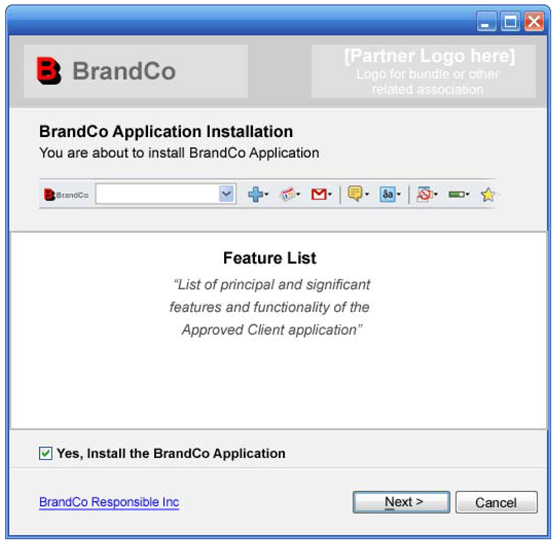
| * | Information redacted pursuant to a confidential treatment request by InfoSpace, Inc. under 5 U.S.C. §552(b)(4) and 17 C.F.R. §§ 200.80(b)(4) and 240.24b-2, and submitted separately with the Securities and Exchange Commission. |
12
Appendix B
Disclosure and Consent Requirements for Changes to an End User’s Default Search
Engine and/or Homepage
(Search-Based Approved Client Applications)
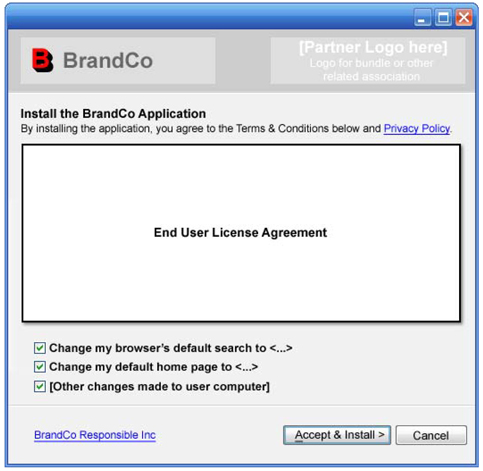
| * | Information redacted pursuant to a confidential treatment request by InfoSpace, Inc. under 5 U.S.C. §552(b)(4) and 17 C.F.R. §§ 200.80(b)(4) and 240.24b-2, and submitted separately with the Securities and Exchange Commission. |
13
Appendix C
Disclosure and Consent Requirements for Changes to an End User’s Default
Search Engine and/or Homepage
(Non-Search Based Approved Client Applications).
Affirmative Consent of End User is Required for Changes to Default Search
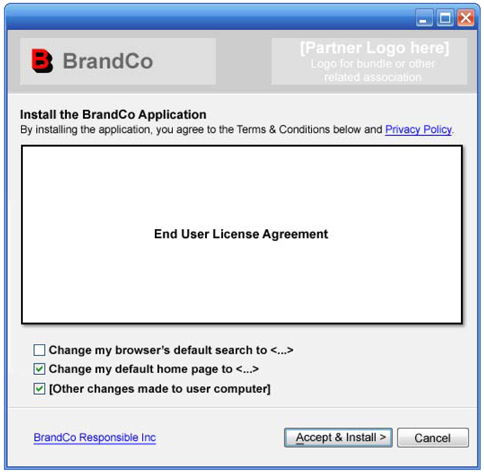
| * | Information redacted pursuant to a confidential treatment request by InfoSpace, Inc. under 5 U.S.C. §552(b)(4) and 17 C.F.R. §§ 200.80(b)(4) and 240.24b-2, and submitted separately with the Securities and Exchange Commission. |
14
Appendix D-1
Results Page UI – up to 3 Wide Ads Above the Fold, up to 8 Narrow Ads Right Rail
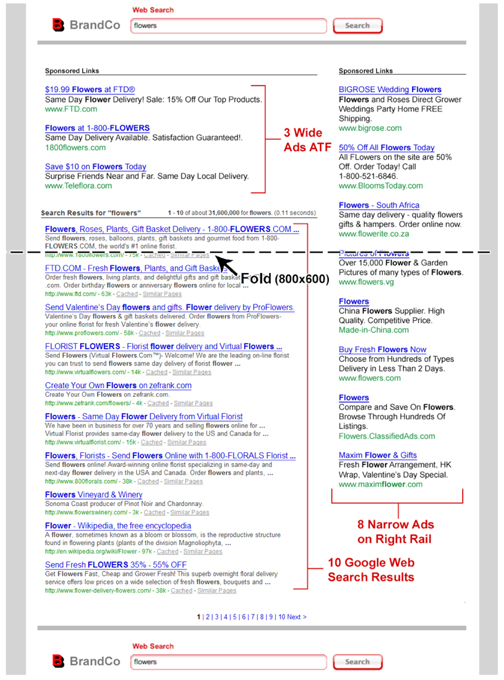
| * | Information redacted pursuant to a confidential treatment request by InfoSpace, Inc. under 5 U.S.C. §552(b)(4) and 17 C.F.R. §§ 200.80(b)(4) and 240.24b-2, and submitted separately with the Securities and Exchange Commission. |
15
Appendix D-2
Results Page UI – up to 3 Wide Ads Above the Fold, Up to 3 Wide Ads Below the Fold.
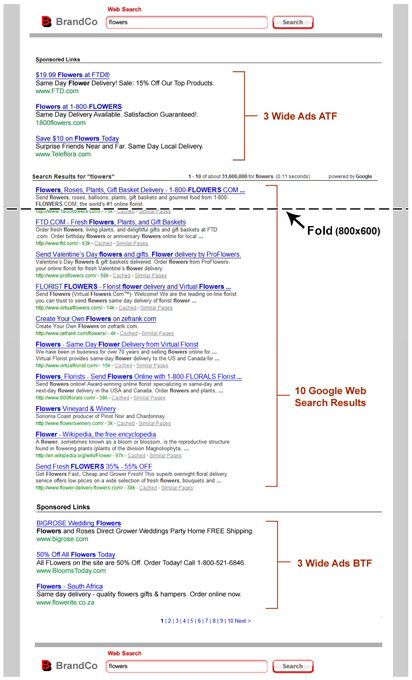
| * | Information redacted pursuant to a confidential treatment request by InfoSpace, Inc. under 5 U.S.C. §552(b)(4) and 17 C.F.R. §§ 200.80(b)(4) and 240.24b-2, and submitted separately with the Securities and Exchange Commission. |
16
Appendix E
Bundling of Applications
When bundling, the End User must be made aware of all the applications included prior to installation.
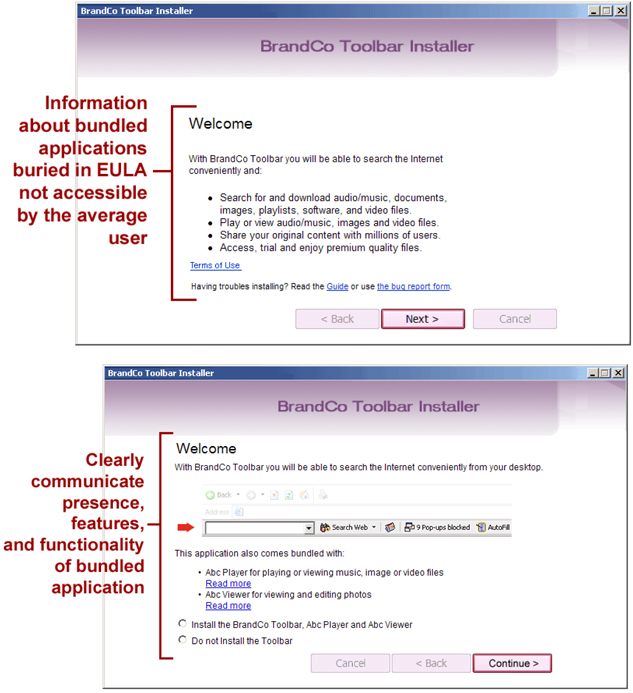
| * | Information redacted pursuant to a confidential treatment request by InfoSpace, Inc. under 5 U.S.C. §552(b)(4) and 17 C.F.R. §§ 200.80(b)(4) and 240.24b-2, and submitted separately with the Securities and Exchange Commission. |
17
Appendix E (continued)
Bundling of Applications
When bundling, the End User must be made aware of advertising revenue relationships to other applications, if the continued use of the primary application is conditioned on the other applications being installed and active on the End User’s computer
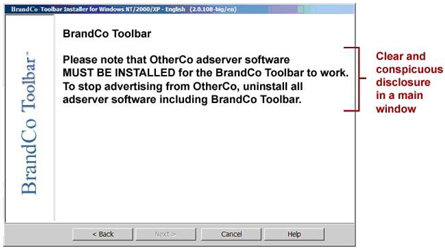
| * | Information redacted pursuant to a confidential treatment request by InfoSpace, Inc. under 5 U.S.C. §552(b)(4) and 17 C.F.R. §§ 200.80(b)(4) and 240.24b-2, and submitted separately with the Securities and Exchange Commission. |
18
Appendix F
Deactivation
The Application must permit End Users to uninstall it in the customary place the applicable operating system has designated for adding or removing programs (e.g., Add/Remove Programs control panel in Windows) in a straightforward manner and must contain (in an easily found location) clear and concise instructions on how it may be uninstalled
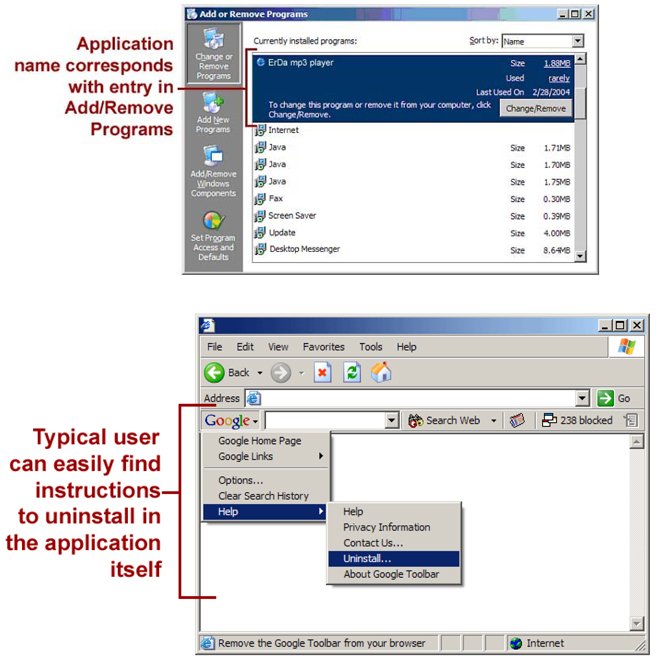
| * | Information redacted pursuant to a confidential treatment request by InfoSpace, Inc. under 5 U.S.C. §552(b)(4) and 17 C.F.R. §§ 200.80(b)(4) and 240.24b-2, and submitted separately with the Securities and Exchange Commission. |
19
